Comprehensive Financial Analysis: Flour Mill and Competitors
VerifiedAdded on 2022/08/21
|19
|3358
|14
Report
AI Summary
This report provides a detailed financial analysis of Flour Mill, a Nigerian company, examining its performance through ratio analysis and Z-score calculations. The analysis covers key financial ratios, including profitability, liquidity, efficiency, and leverage ratios, comparing Flour Mill's performance with its competitors. The report evaluates the company's financial position from 2016 to 2018, highlighting trends in gross profit margin, profit margin, return on equity, return on assets, current ratio, quick ratio, and debt ratios. The Z-score analysis assesses the company's likelihood of bankruptcy. The report concludes with recommendations based on the financial findings. The report also includes financial data for Honeywell Flour, UAC of Nigeria, and PZ Cussons for comparative analysis. The study is designed to provide a comprehensive understanding of Flour Mill's financial health and performance, offering insights into its strengths, weaknesses, and overall financial stability.

Accounting
Paraphrase This Document
Need a fresh take? Get an instant paraphrase of this document with our AI Paraphraser
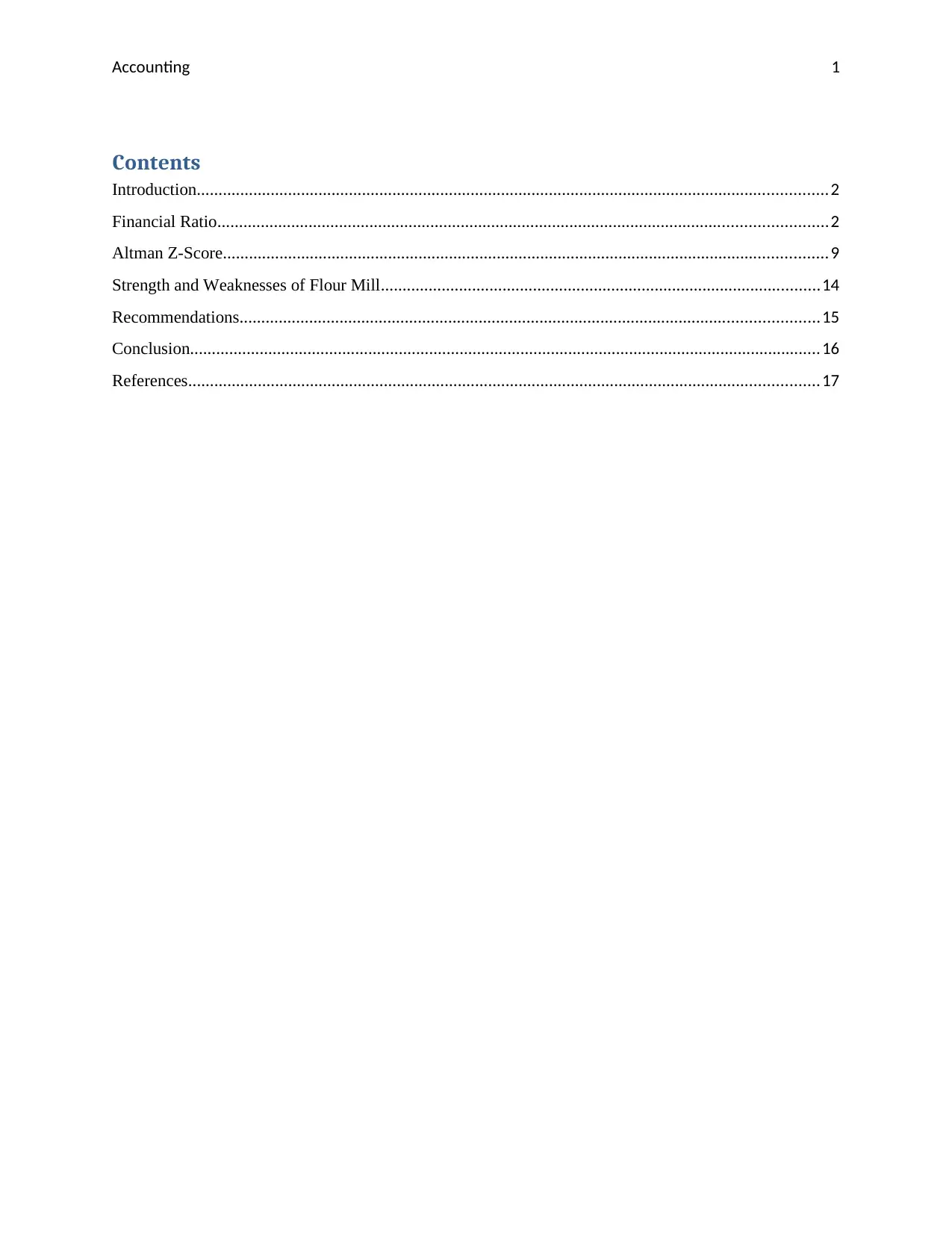
Accounting 1
Contents
Introduction.................................................................................................................................................2
Financial Ratio............................................................................................................................................2
Altman Z-Score...........................................................................................................................................9
Strength and Weaknesses of Flour Mill.....................................................................................................14
Recommendations.....................................................................................................................................15
Conclusion.................................................................................................................................................16
References.................................................................................................................................................17
Contents
Introduction.................................................................................................................................................2
Financial Ratio............................................................................................................................................2
Altman Z-Score...........................................................................................................................................9
Strength and Weaknesses of Flour Mill.....................................................................................................14
Recommendations.....................................................................................................................................15
Conclusion.................................................................................................................................................16
References.................................................................................................................................................17
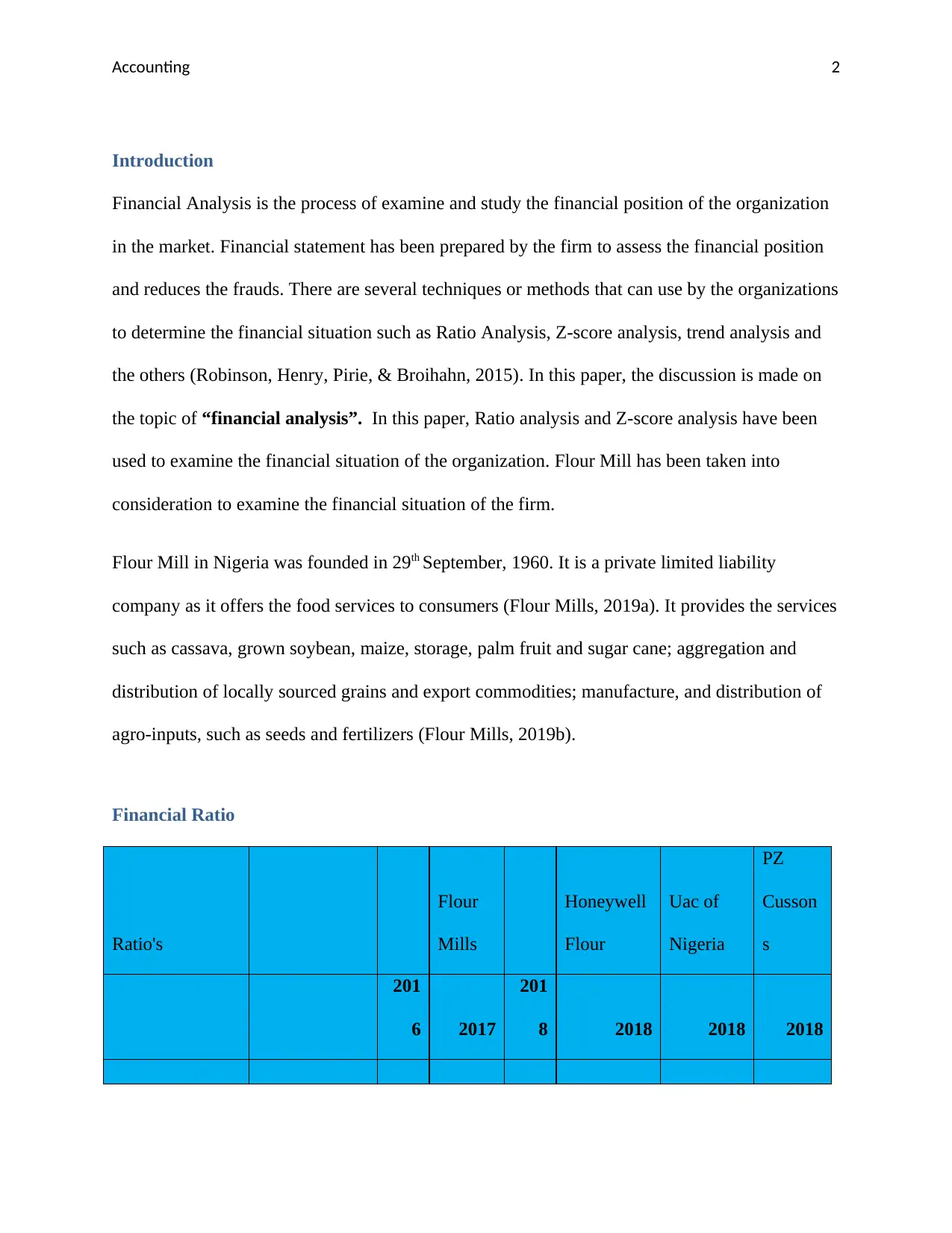
Accounting 2
Introduction
Financial Analysis is the process of examine and study the financial position of the organization
in the market. Financial statement has been prepared by the firm to assess the financial position
and reduces the frauds. There are several techniques or methods that can use by the organizations
to determine the financial situation such as Ratio Analysis, Z-score analysis, trend analysis and
the others (Robinson, Henry, Pirie, & Broihahn, 2015). In this paper, the discussion is made on
the topic of “financial analysis”. In this paper, Ratio analysis and Z-score analysis have been
used to examine the financial situation of the organization. Flour Mill has been taken into
consideration to examine the financial situation of the firm.
Flour Mill in Nigeria was founded in 29th September, 1960. It is a private limited liability
company as it offers the food services to consumers (Flour Mills, 2019a). It provides the services
such as cassava, grown soybean, maize, storage, palm fruit and sugar cane; aggregation and
distribution of locally sourced grains and export commodities; manufacture, and distribution of
agro-inputs, such as seeds and fertilizers (Flour Mills, 2019b).
Financial Ratio
Ratio's
Flour
Mills
Honeywell
Flour
Uac of
Nigeria
PZ
Cusson
s
201
6 2017
201
8 2018 2018 2018
Introduction
Financial Analysis is the process of examine and study the financial position of the organization
in the market. Financial statement has been prepared by the firm to assess the financial position
and reduces the frauds. There are several techniques or methods that can use by the organizations
to determine the financial situation such as Ratio Analysis, Z-score analysis, trend analysis and
the others (Robinson, Henry, Pirie, & Broihahn, 2015). In this paper, the discussion is made on
the topic of “financial analysis”. In this paper, Ratio analysis and Z-score analysis have been
used to examine the financial situation of the organization. Flour Mill has been taken into
consideration to examine the financial situation of the firm.
Flour Mill in Nigeria was founded in 29th September, 1960. It is a private limited liability
company as it offers the food services to consumers (Flour Mills, 2019a). It provides the services
such as cassava, grown soybean, maize, storage, palm fruit and sugar cane; aggregation and
distribution of locally sourced grains and export commodities; manufacture, and distribution of
agro-inputs, such as seeds and fertilizers (Flour Mills, 2019b).
Financial Ratio
Ratio's
Flour
Mills
Honeywell
Flour
Uac of
Nigeria
PZ
Cusson
s
201
6 2017
201
8 2018 2018 2018
⊘ This is a preview!⊘
Do you want full access?
Subscribe today to unlock all pages.

Trusted by 1+ million students worldwide

Accounting 3
Profitability
Ratio
Gross Profit
Margin Gross Profit
37.6
2 67.42
68.7
8 16.05 14.04 18.6
Net Sales
342.
59 524.46
542.
67 71.48 78.74 58.48
11% 13% 13% 22% 18% 32%
Profit Margin Net Profit
14.4
2 8.84
13.6
2 4.43 9.47 16.3
Net Sales
342.
59 524.46
542.
67 71.48 78.74 58.48
4% 2% 3% 6% 12% 28%
Return on Equity
Profit avail to
owners
14.4
2 8.84
13.6
2 4.43 9.47 16.3
Average
Equity
91.5
9 99.16
126.
58 54.36 73.67 33.91
16% 9% 11% 8.1% 12.9% 48%
Return on Assets
Net profit
(loss)
14.4
2 8.84
13.6
2 4.43 9.47 16.3
Average total
assets
344.
10 413.98
445.
48 119 130.86 73.80
4% 2% 3.1 3.7% 7.2% 22.1%
Profitability
Ratio
Gross Profit
Margin Gross Profit
37.6
2 67.42
68.7
8 16.05 14.04 18.6
Net Sales
342.
59 524.46
542.
67 71.48 78.74 58.48
11% 13% 13% 22% 18% 32%
Profit Margin Net Profit
14.4
2 8.84
13.6
2 4.43 9.47 16.3
Net Sales
342.
59 524.46
542.
67 71.48 78.74 58.48
4% 2% 3% 6% 12% 28%
Return on Equity
Profit avail to
owners
14.4
2 8.84
13.6
2 4.43 9.47 16.3
Average
Equity
91.5
9 99.16
126.
58 54.36 73.67 33.91
16% 9% 11% 8.1% 12.9% 48%
Return on Assets
Net profit
(loss)
14.4
2 8.84
13.6
2 4.43 9.47 16.3
Average total
assets
344.
10 413.98
445.
48 119 130.86 73.80
4% 2% 3.1 3.7% 7.2% 22.1%
Paraphrase This Document
Need a fresh take? Get an instant paraphrase of this document with our AI Paraphraser
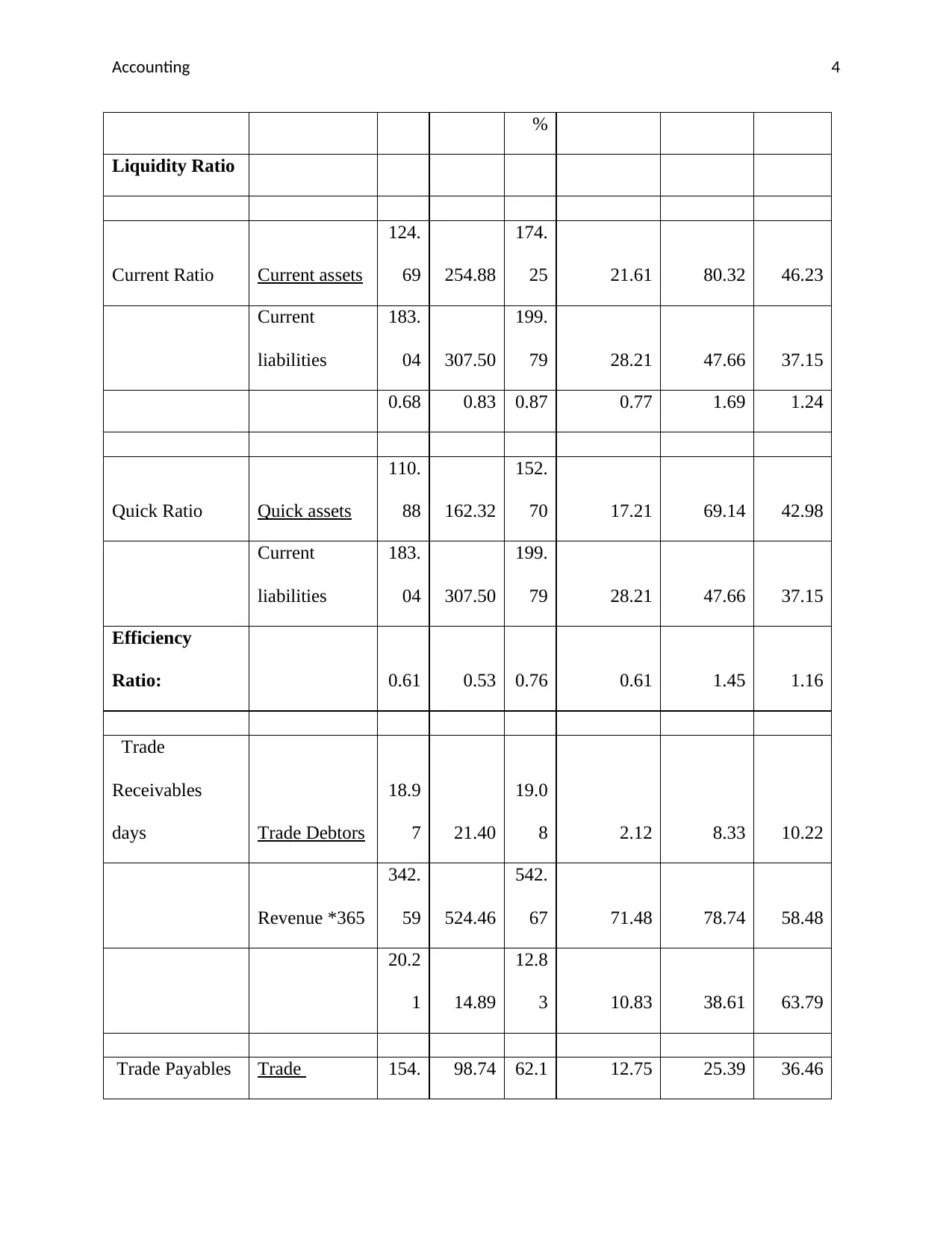
Accounting 4
%
Liquidity Ratio
Current Ratio Current assets
124.
69 254.88
174.
25 21.61 80.32 46.23
Current
liabilities
183.
04 307.50
199.
79 28.21 47.66 37.15
0.68 0.83 0.87 0.77 1.69 1.24
Quick Ratio Quick assets
110.
88 162.32
152.
70 17.21 69.14 42.98
Current
liabilities
183.
04 307.50
199.
79 28.21 47.66 37.15
Efficiency
Ratio: 0.61 0.53 0.76 0.61 1.45 1.16
Trade
Receivables
days Trade Debtors
18.9
7 21.40
19.0
8 2.12 8.33 10.22
Revenue *365
342.
59 524.46
542.
67 71.48 78.74 58.48
20.2
1 14.89
12.8
3 10.83 38.61 63.79
Trade Payables Trade 154. 98.74 62.1 12.75 25.39 36.46
%
Liquidity Ratio
Current Ratio Current assets
124.
69 254.88
174.
25 21.61 80.32 46.23
Current
liabilities
183.
04 307.50
199.
79 28.21 47.66 37.15
0.68 0.83 0.87 0.77 1.69 1.24
Quick Ratio Quick assets
110.
88 162.32
152.
70 17.21 69.14 42.98
Current
liabilities
183.
04 307.50
199.
79 28.21 47.66 37.15
Efficiency
Ratio: 0.61 0.53 0.76 0.61 1.45 1.16
Trade
Receivables
days Trade Debtors
18.9
7 21.40
19.0
8 2.12 8.33 10.22
Revenue *365
342.
59 524.46
542.
67 71.48 78.74 58.48
20.2
1 14.89
12.8
3 10.83 38.61 63.79
Trade Payables Trade 154. 98.74 62.1 12.75 25.39 36.46
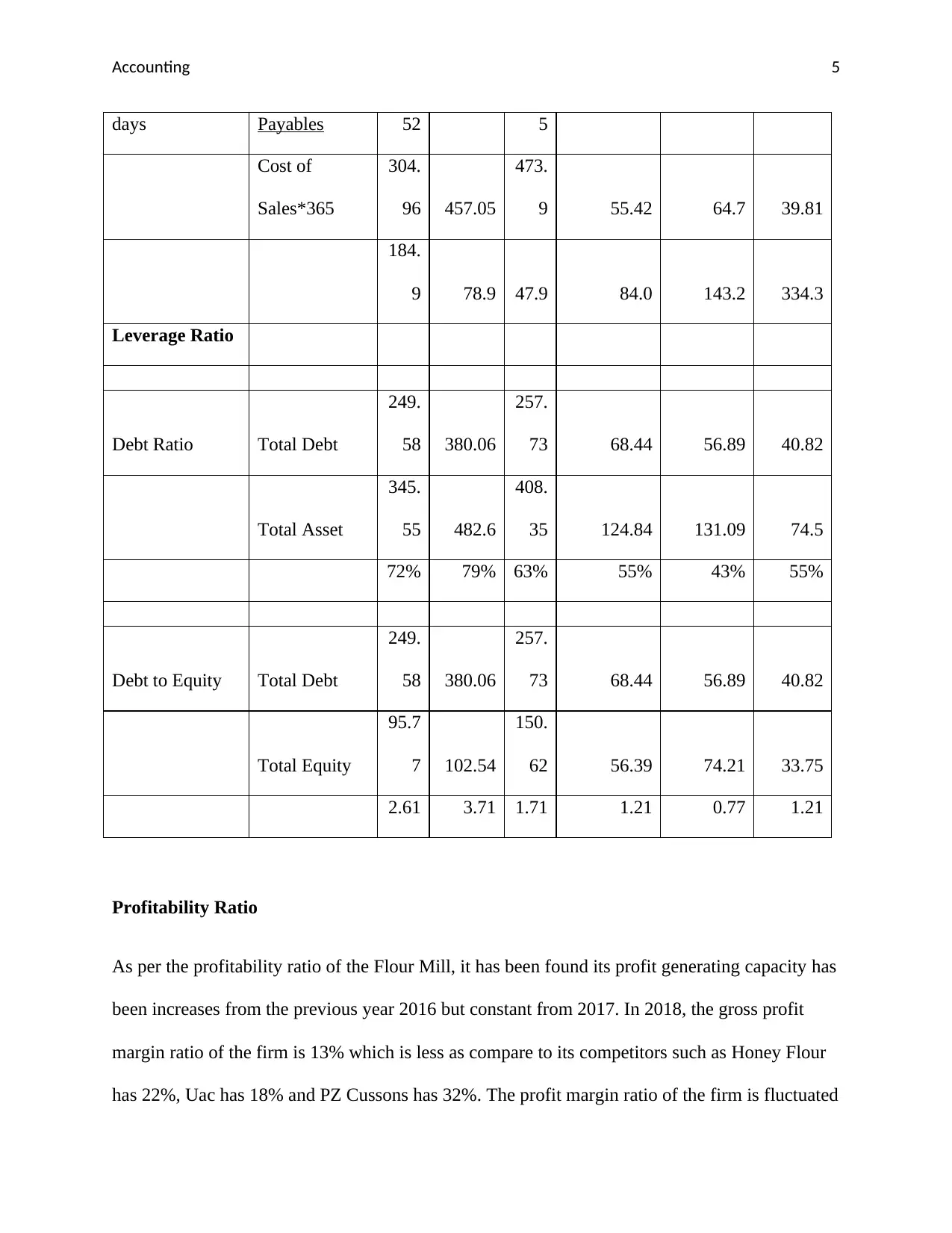
Accounting 5
days Payables 52 5
Cost of
Sales*365
304.
96 457.05
473.
9 55.42 64.7 39.81
184.
9 78.9 47.9 84.0 143.2 334.3
Leverage Ratio
Debt Ratio Total Debt
249.
58 380.06
257.
73 68.44 56.89 40.82
Total Asset
345.
55 482.6
408.
35 124.84 131.09 74.5
72% 79% 63% 55% 43% 55%
Debt to Equity Total Debt
249.
58 380.06
257.
73 68.44 56.89 40.82
Total Equity
95.7
7 102.54
150.
62 56.39 74.21 33.75
2.61 3.71 1.71 1.21 0.77 1.21
Profitability Ratio
As per the profitability ratio of the Flour Mill, it has been found its profit generating capacity has
been increases from the previous year 2016 but constant from 2017. In 2018, the gross profit
margin ratio of the firm is 13% which is less as compare to its competitors such as Honey Flour
has 22%, Uac has 18% and PZ Cussons has 32%. The profit margin ratio of the firm is fluctuated
days Payables 52 5
Cost of
Sales*365
304.
96 457.05
473.
9 55.42 64.7 39.81
184.
9 78.9 47.9 84.0 143.2 334.3
Leverage Ratio
Debt Ratio Total Debt
249.
58 380.06
257.
73 68.44 56.89 40.82
Total Asset
345.
55 482.6
408.
35 124.84 131.09 74.5
72% 79% 63% 55% 43% 55%
Debt to Equity Total Debt
249.
58 380.06
257.
73 68.44 56.89 40.82
Total Equity
95.7
7 102.54
150.
62 56.39 74.21 33.75
2.61 3.71 1.71 1.21 0.77 1.21
Profitability Ratio
As per the profitability ratio of the Flour Mill, it has been found its profit generating capacity has
been increases from the previous year 2016 but constant from 2017. In 2018, the gross profit
margin ratio of the firm is 13% which is less as compare to its competitors such as Honey Flour
has 22%, Uac has 18% and PZ Cussons has 32%. The profit margin ratio of the firm is fluctuated
⊘ This is a preview!⊘
Do you want full access?
Subscribe today to unlock all pages.

Trusted by 1+ million students worldwide

Accounting 6
in last three years such as 4%, 2% and 3% in 2016, 2017 and 2018 respectively (Morning Star,
2018a). It has been estimated that the net margin of competitors are Honey Flour has 6%, Uac
has 12% and PZ Cussons has 28% which depicts that the profit margin percentage is also less as
compare to the competitors of the company (PZ Cussons, 2018).
2018
0%
10%
20%
30%
40%
50%
60%
Return on Equity
Flour Mills
Honeywell Flour
Uac of Nigeria
PZ cussons
According to the Return on Equity ratio, it has been estimated that the Flour Mills provides the
11% of return to their shareholders which is moderate as compare to its competitors except PZ
Cussons. PZ Cussons is the company that provides the high amount of return with the percentage
of 48%. Uac also provides the high percentage of return to shareholders as compare to Flour
Mills such as 12.9% in the year 2018. In the year 2018, Return on Assets of Flour Mills has 3.1%
Honey Flour has 3.7%, Uac has 7.2% and PZ Cussons has 22.1% which depicts that Flour Mills
is not able to generate the profit by using the assets as compare to the competitors (Faello,
2015).
Liquidity Ratio
in last three years such as 4%, 2% and 3% in 2016, 2017 and 2018 respectively (Morning Star,
2018a). It has been estimated that the net margin of competitors are Honey Flour has 6%, Uac
has 12% and PZ Cussons has 28% which depicts that the profit margin percentage is also less as
compare to the competitors of the company (PZ Cussons, 2018).
2018
0%
10%
20%
30%
40%
50%
60%
Return on Equity
Flour Mills
Honeywell Flour
Uac of Nigeria
PZ cussons
According to the Return on Equity ratio, it has been estimated that the Flour Mills provides the
11% of return to their shareholders which is moderate as compare to its competitors except PZ
Cussons. PZ Cussons is the company that provides the high amount of return with the percentage
of 48%. Uac also provides the high percentage of return to shareholders as compare to Flour
Mills such as 12.9% in the year 2018. In the year 2018, Return on Assets of Flour Mills has 3.1%
Honey Flour has 3.7%, Uac has 7.2% and PZ Cussons has 22.1% which depicts that Flour Mills
is not able to generate the profit by using the assets as compare to the competitors (Faello,
2015).
Liquidity Ratio
Paraphrase This Document
Need a fresh take? Get an instant paraphrase of this document with our AI Paraphraser

Accounting 7
2018
0.00
0.20
0.40
0.60
0.80
1.00
1.20
1.40
1.60
1.80
Current Ratio
Flour Mills
Honeywell Flour
Uac of Nigeria
PZ cussons
According to the Current Assets ratio, it has been determined that the current ratio of Flour Mills
is 0.87 in the year 2018. In 2016 and 2017, it has been found that 0.68 and 0.83 are the current
ratio of the firm which depicts that the current ratio has been increasing due to increasing current
assets (Clear Tax, 2018). The current liabilities of the firm have been decreases in 2018 with the
decreasing current assets. The current liquidity position of the organization is not good due to
decreasing current assets. The capability of the firm to pay the liabilities is high as compare to
the firm such as Uac has 1.69% and PZ Cussons has 1.24% but current ratio of Honey Flour
Mills is 0.77 which is less than Flour Mill (Morning Star, 2018b).
Efficiency Ratio
Efficiency Ratio contains the trade receivables and trade payable ratio in order to determine the
efficiency of the company (Zainudin, & Hashim, 2016). As per the trade receivable ratio, it has
been determined that the company collects the amount in 12.83 days in the year 2018 and its
competitors receives in 10.83, 38.61 and 63.79 Honeywell Flour, Uac of Nigeria and PZ Cussons
respectively. It has been found that the Flour Mills collects the amount in minimum days which
is beneficial for its net profit and it also pay the amount in less days such as 47.9 days which is
2018
0.00
0.20
0.40
0.60
0.80
1.00
1.20
1.40
1.60
1.80
Current Ratio
Flour Mills
Honeywell Flour
Uac of Nigeria
PZ cussons
According to the Current Assets ratio, it has been determined that the current ratio of Flour Mills
is 0.87 in the year 2018. In 2016 and 2017, it has been found that 0.68 and 0.83 are the current
ratio of the firm which depicts that the current ratio has been increasing due to increasing current
assets (Clear Tax, 2018). The current liabilities of the firm have been decreases in 2018 with the
decreasing current assets. The current liquidity position of the organization is not good due to
decreasing current assets. The capability of the firm to pay the liabilities is high as compare to
the firm such as Uac has 1.69% and PZ Cussons has 1.24% but current ratio of Honey Flour
Mills is 0.77 which is less than Flour Mill (Morning Star, 2018b).
Efficiency Ratio
Efficiency Ratio contains the trade receivables and trade payable ratio in order to determine the
efficiency of the company (Zainudin, & Hashim, 2016). As per the trade receivable ratio, it has
been determined that the company collects the amount in 12.83 days in the year 2018 and its
competitors receives in 10.83, 38.61 and 63.79 Honeywell Flour, Uac of Nigeria and PZ Cussons
respectively. It has been found that the Flour Mills collects the amount in minimum days which
is beneficial for its net profit and it also pay the amount in less days such as 47.9 days which is
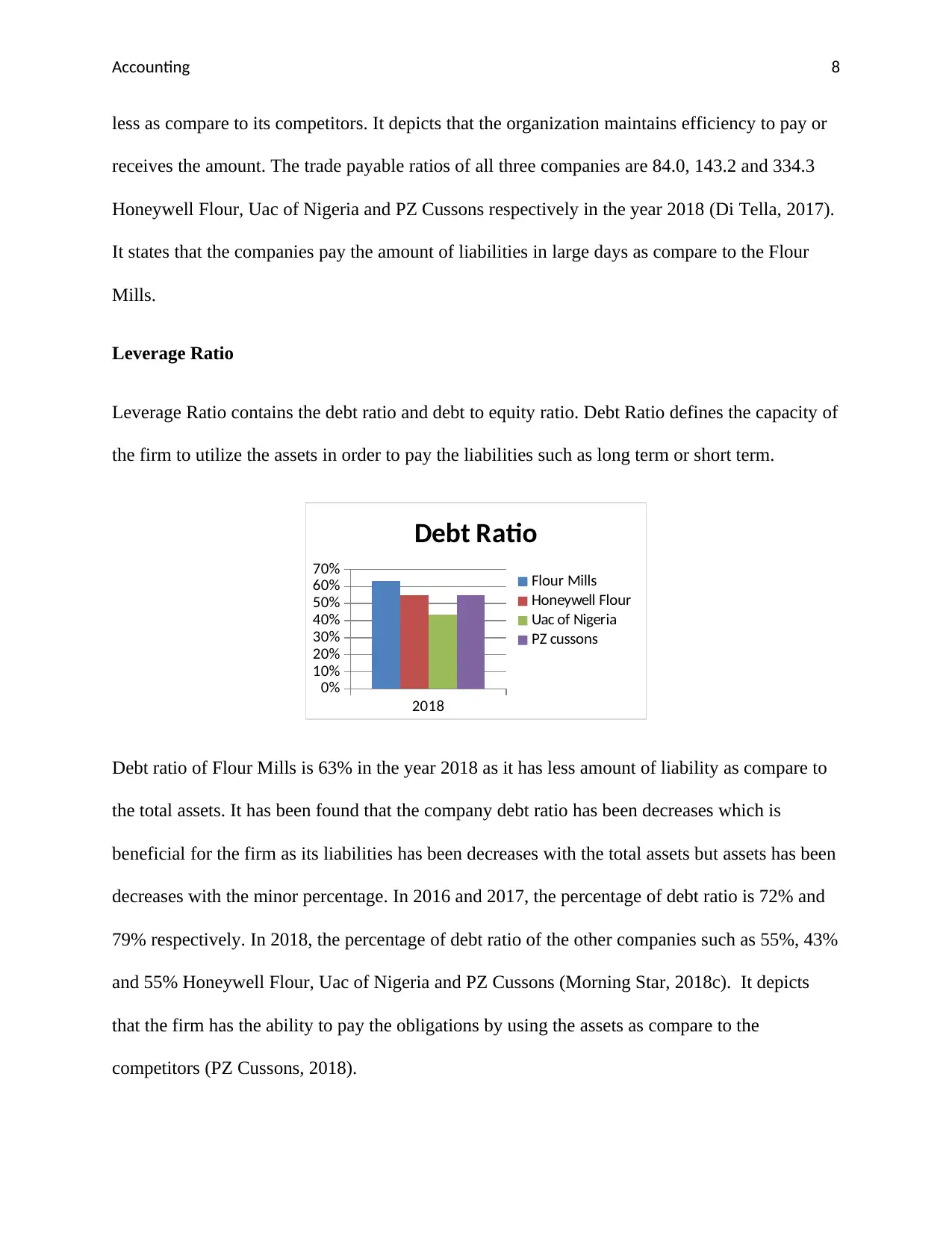
Accounting 8
less as compare to its competitors. It depicts that the organization maintains efficiency to pay or
receives the amount. The trade payable ratios of all three companies are 84.0, 143.2 and 334.3
Honeywell Flour, Uac of Nigeria and PZ Cussons respectively in the year 2018 (Di Tella, 2017).
It states that the companies pay the amount of liabilities in large days as compare to the Flour
Mills.
Leverage Ratio
Leverage Ratio contains the debt ratio and debt to equity ratio. Debt Ratio defines the capacity of
the firm to utilize the assets in order to pay the liabilities such as long term or short term.
2018
0%
10%
20%
30%
40%
50%
60%
70%
Debt Ratio
Flour Mills
Honeywell Flour
Uac of Nigeria
PZ cussons
Debt ratio of Flour Mills is 63% in the year 2018 as it has less amount of liability as compare to
the total assets. It has been found that the company debt ratio has been decreases which is
beneficial for the firm as its liabilities has been decreases with the total assets but assets has been
decreases with the minor percentage. In 2016 and 2017, the percentage of debt ratio is 72% and
79% respectively. In 2018, the percentage of debt ratio of the other companies such as 55%, 43%
and 55% Honeywell Flour, Uac of Nigeria and PZ Cussons (Morning Star, 2018c). It depicts
that the firm has the ability to pay the obligations by using the assets as compare to the
competitors (PZ Cussons, 2018).
less as compare to its competitors. It depicts that the organization maintains efficiency to pay or
receives the amount. The trade payable ratios of all three companies are 84.0, 143.2 and 334.3
Honeywell Flour, Uac of Nigeria and PZ Cussons respectively in the year 2018 (Di Tella, 2017).
It states that the companies pay the amount of liabilities in large days as compare to the Flour
Mills.
Leverage Ratio
Leverage Ratio contains the debt ratio and debt to equity ratio. Debt Ratio defines the capacity of
the firm to utilize the assets in order to pay the liabilities such as long term or short term.
2018
0%
10%
20%
30%
40%
50%
60%
70%
Debt Ratio
Flour Mills
Honeywell Flour
Uac of Nigeria
PZ cussons
Debt ratio of Flour Mills is 63% in the year 2018 as it has less amount of liability as compare to
the total assets. It has been found that the company debt ratio has been decreases which is
beneficial for the firm as its liabilities has been decreases with the total assets but assets has been
decreases with the minor percentage. In 2016 and 2017, the percentage of debt ratio is 72% and
79% respectively. In 2018, the percentage of debt ratio of the other companies such as 55%, 43%
and 55% Honeywell Flour, Uac of Nigeria and PZ Cussons (Morning Star, 2018c). It depicts
that the firm has the ability to pay the obligations by using the assets as compare to the
competitors (PZ Cussons, 2018).
⊘ This is a preview!⊘
Do you want full access?
Subscribe today to unlock all pages.

Trusted by 1+ million students worldwide
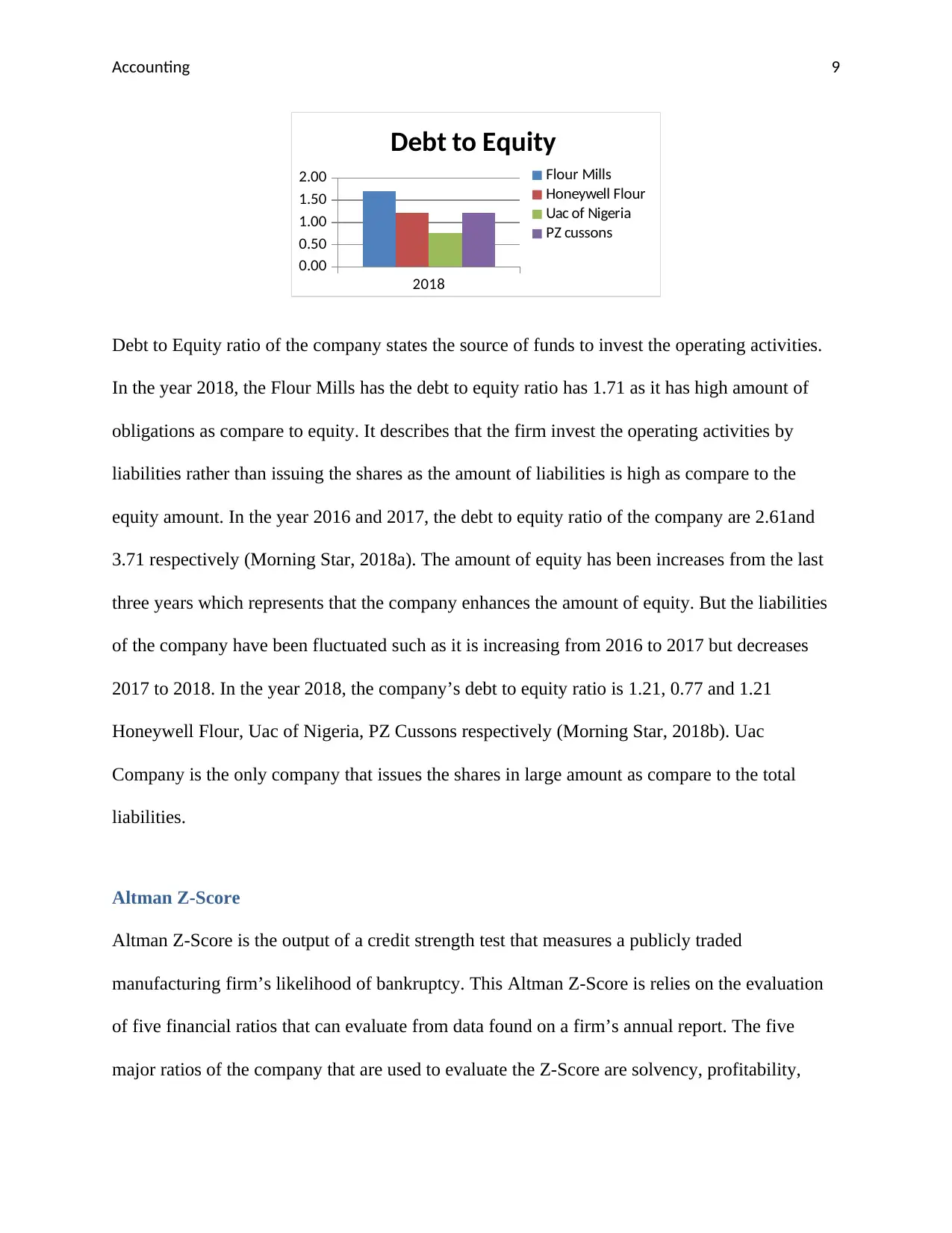
Accounting 9
2018
0.00
0.50
1.00
1.50
2.00
Debt to Equity
Flour Mills
Honeywell Flour
Uac of Nigeria
PZ cussons
Debt to Equity ratio of the company states the source of funds to invest the operating activities.
In the year 2018, the Flour Mills has the debt to equity ratio has 1.71 as it has high amount of
obligations as compare to equity. It describes that the firm invest the operating activities by
liabilities rather than issuing the shares as the amount of liabilities is high as compare to the
equity amount. In the year 2016 and 2017, the debt to equity ratio of the company are 2.61and
3.71 respectively (Morning Star, 2018a). The amount of equity has been increases from the last
three years which represents that the company enhances the amount of equity. But the liabilities
of the company have been fluctuated such as it is increasing from 2016 to 2017 but decreases
2017 to 2018. In the year 2018, the company’s debt to equity ratio is 1.21, 0.77 and 1.21
Honeywell Flour, Uac of Nigeria, PZ Cussons respectively (Morning Star, 2018b). Uac
Company is the only company that issues the shares in large amount as compare to the total
liabilities.
Altman Z-Score
Altman Z-Score is the output of a credit strength test that measures a publicly traded
manufacturing firm’s likelihood of bankruptcy. This Altman Z-Score is relies on the evaluation
of five financial ratios that can evaluate from data found on a firm’s annual report. The five
major ratios of the company that are used to evaluate the Z-Score are solvency, profitability,
2018
0.00
0.50
1.00
1.50
2.00
Debt to Equity
Flour Mills
Honeywell Flour
Uac of Nigeria
PZ cussons
Debt to Equity ratio of the company states the source of funds to invest the operating activities.
In the year 2018, the Flour Mills has the debt to equity ratio has 1.71 as it has high amount of
obligations as compare to equity. It describes that the firm invest the operating activities by
liabilities rather than issuing the shares as the amount of liabilities is high as compare to the
equity amount. In the year 2016 and 2017, the debt to equity ratio of the company are 2.61and
3.71 respectively (Morning Star, 2018a). The amount of equity has been increases from the last
three years which represents that the company enhances the amount of equity. But the liabilities
of the company have been fluctuated such as it is increasing from 2016 to 2017 but decreases
2017 to 2018. In the year 2018, the company’s debt to equity ratio is 1.21, 0.77 and 1.21
Honeywell Flour, Uac of Nigeria, PZ Cussons respectively (Morning Star, 2018b). Uac
Company is the only company that issues the shares in large amount as compare to the total
liabilities.
Altman Z-Score
Altman Z-Score is the output of a credit strength test that measures a publicly traded
manufacturing firm’s likelihood of bankruptcy. This Altman Z-Score is relies on the evaluation
of five financial ratios that can evaluate from data found on a firm’s annual report. The five
major ratios of the company that are used to evaluate the Z-Score are solvency, profitability,
Paraphrase This Document
Need a fresh take? Get an instant paraphrase of this document with our AI Paraphraser

Accounting 10
leverage, liquidity and activity to estimate the financial position whether the organization has
high profitability of becoming insolvent.
According to this technique, the company who has 1.8 score might be headed for bankruptcy and
3 score states the solid financial positioning. This Altman Z-Score has been evaluated with the
formula:
Z-Score = 1.2A + 1.4B + 3.3C + 0.6D + 1.0E
In this formula, A= Working Capital/ Total Assets
B = Retained earnings / total assets
C = Earnings before interest and tax / total assets
D = Market value of equity / total liabilities
E = Sales / total assets
The analysis of Z-Score has been done as per the below guidelines:
• When Z is >= 3.0, the company is most likely to be safe as per the financial data
• When Z is 2.7 to 3.0, the corporation is probably safe from bankruptcy, but this is in the
grey area and caution should be taken.
• When Z is 1.8 to 2.7, the firm is likely to be bankrupt within 2 years.
• When Z is <= 1.8, the firm is highly likely to be bankrupt.
The Z-Score has been calculated to examine the financial situation of the firm and its
competitors.
leverage, liquidity and activity to estimate the financial position whether the organization has
high profitability of becoming insolvent.
According to this technique, the company who has 1.8 score might be headed for bankruptcy and
3 score states the solid financial positioning. This Altman Z-Score has been evaluated with the
formula:
Z-Score = 1.2A + 1.4B + 3.3C + 0.6D + 1.0E
In this formula, A= Working Capital/ Total Assets
B = Retained earnings / total assets
C = Earnings before interest and tax / total assets
D = Market value of equity / total liabilities
E = Sales / total assets
The analysis of Z-Score has been done as per the below guidelines:
• When Z is >= 3.0, the company is most likely to be safe as per the financial data
• When Z is 2.7 to 3.0, the corporation is probably safe from bankruptcy, but this is in the
grey area and caution should be taken.
• When Z is 1.8 to 2.7, the firm is likely to be bankrupt within 2 years.
• When Z is <= 1.8, the firm is highly likely to be bankrupt.
The Z-Score has been calculated to examine the financial situation of the firm and its
competitors.
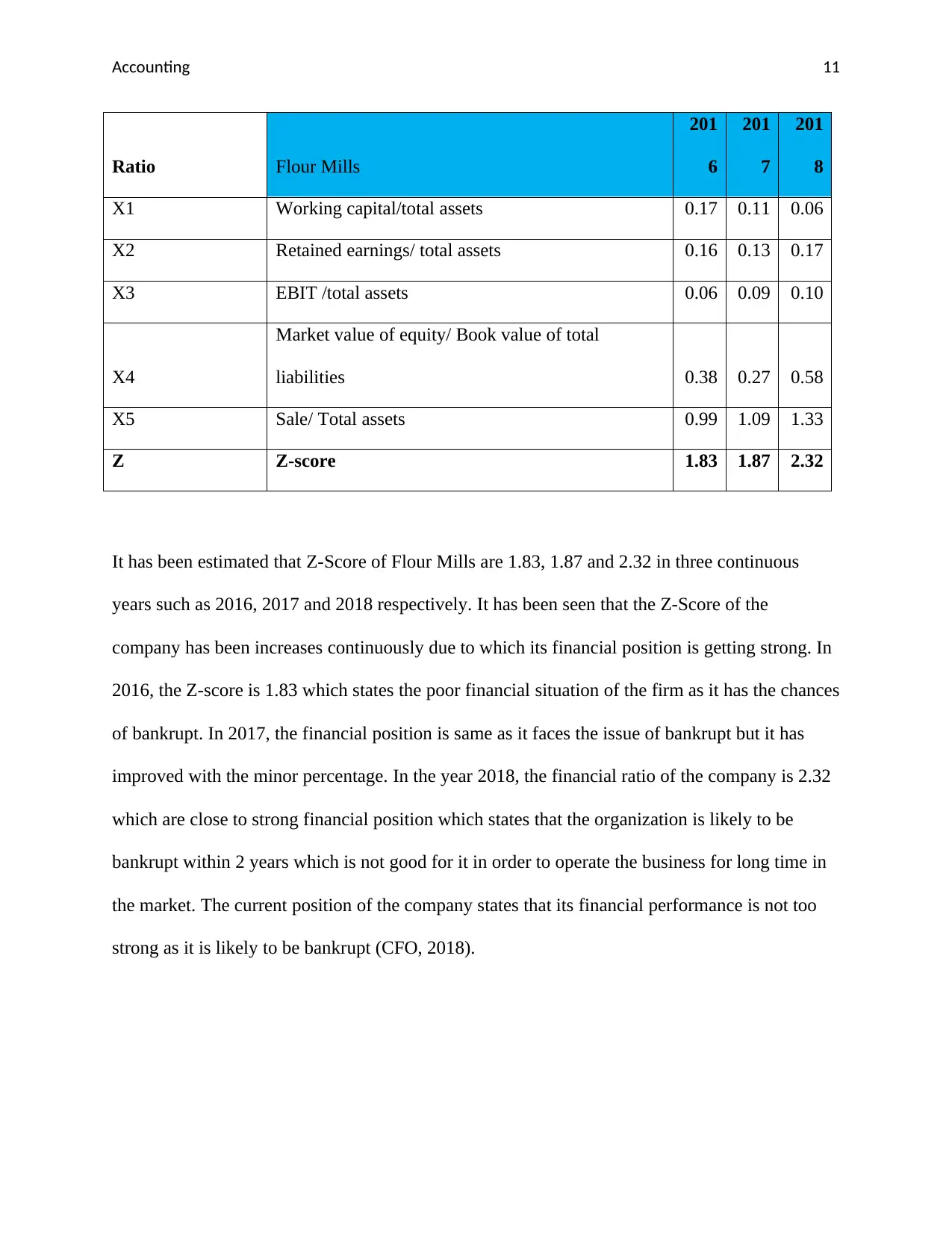
Accounting 11
Ratio Flour Mills
201
6
201
7
201
8
X1 Working capital/total assets 0.17 0.11 0.06
X2 Retained earnings/ total assets 0.16 0.13 0.17
X3 EBIT /total assets 0.06 0.09 0.10
X4
Market value of equity/ Book value of total
liabilities 0.38 0.27 0.58
X5 Sale/ Total assets 0.99 1.09 1.33
Z Z-score 1.83 1.87 2.32
It has been estimated that Z-Score of Flour Mills are 1.83, 1.87 and 2.32 in three continuous
years such as 2016, 2017 and 2018 respectively. It has been seen that the Z-Score of the
company has been increases continuously due to which its financial position is getting strong. In
2016, the Z-score is 1.83 which states the poor financial situation of the firm as it has the chances
of bankrupt. In 2017, the financial position is same as it faces the issue of bankrupt but it has
improved with the minor percentage. In the year 2018, the financial ratio of the company is 2.32
which are close to strong financial position which states that the organization is likely to be
bankrupt within 2 years which is not good for it in order to operate the business for long time in
the market. The current position of the company states that its financial performance is not too
strong as it is likely to be bankrupt (CFO, 2018).
Ratio Flour Mills
201
6
201
7
201
8
X1 Working capital/total assets 0.17 0.11 0.06
X2 Retained earnings/ total assets 0.16 0.13 0.17
X3 EBIT /total assets 0.06 0.09 0.10
X4
Market value of equity/ Book value of total
liabilities 0.38 0.27 0.58
X5 Sale/ Total assets 0.99 1.09 1.33
Z Z-score 1.83 1.87 2.32
It has been estimated that Z-Score of Flour Mills are 1.83, 1.87 and 2.32 in three continuous
years such as 2016, 2017 and 2018 respectively. It has been seen that the Z-Score of the
company has been increases continuously due to which its financial position is getting strong. In
2016, the Z-score is 1.83 which states the poor financial situation of the firm as it has the chances
of bankrupt. In 2017, the financial position is same as it faces the issue of bankrupt but it has
improved with the minor percentage. In the year 2018, the financial ratio of the company is 2.32
which are close to strong financial position which states that the organization is likely to be
bankrupt within 2 years which is not good for it in order to operate the business for long time in
the market. The current position of the company states that its financial performance is not too
strong as it is likely to be bankrupt (CFO, 2018).
⊘ This is a preview!⊘
Do you want full access?
Subscribe today to unlock all pages.

Trusted by 1+ million students worldwide
1 out of 19
Your All-in-One AI-Powered Toolkit for Academic Success.
+13062052269
info@desklib.com
Available 24*7 on WhatsApp / Email
![[object Object]](/_next/static/media/star-bottom.7253800d.svg)
Unlock your academic potential
Copyright © 2020–2025 A2Z Services. All Rights Reserved. Developed and managed by ZUCOL.